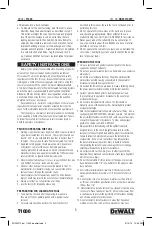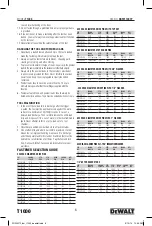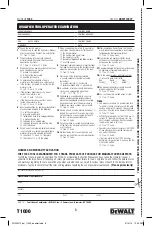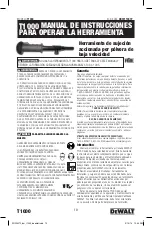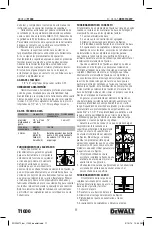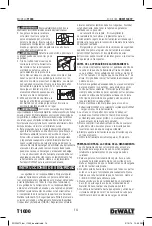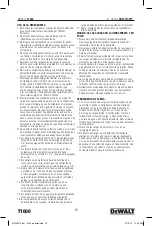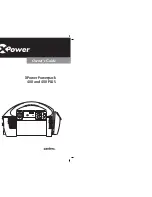
T1000
Model
T1000
Cat. No.
DDF211001P
4
diameter. Do not over tighten threaded parts. Maximum
tightening torque values are listed in the table below. Use of
a nut setter is recommended to reduce the possibility of over
tightening the fasteners. for critical applications, perform a
job site test.
MAxIMUM TORqUE
FOR 1/4” STUD (FT.-LBS)
MAxIMUM TORqUE
FOR 3/8” STUD (FT.-LBS)
2
4
inSTallaTion in STeel
The following guidelines are based on the installation of
a fastener in ASTM A 36 structural steel with the point fully
penetrating the steel member. Recommended steel material
thickness ranges from a minimum of 1/8” to a maximum of
3/8”. for use in higher strength structural steel, applications
where the point does not penetrate the steel member, or a
thickness of steel greater than 3/8”, job site performance
tests are recommended.
baSe MaTeRial ThickneSS
Steel base materials should be a minimum of 1/8” in
thickness.
eDge DiSTance
for installations in A 36 steel, 1/2” is the recommended
minimum edge distance.
Spacing
The recommended minimum distance between fastenings
is 1-1/2” center to center for installations in ASTM A 36
steel.
FaSTeneR lengTh SelecTion in STeel
for permanent applications when using pins in steel, first
determine the thickness of the fixture to be fastened. To this,
add the thickness of the steel base material plus a minimum
of 1/4” to allow for proper point penetration. This will be the
minimum fastener shank length required. Do not select a
fastener length longer than that required for the application.
An excessively long shank can burnish or polish the hole
created in the steel resulting in a reduction in load capacity.
for removable applications with threaded studs, the
shank length required is equal to the thickness of the steel
base material plus a minimum of 1/4” to allow for proper
point penetration. This will be the minimum fastener shank
length required. Do not select a shank length longer than
that required for the application. An excessively long shank
can burnish or polish the hole created in the steel resulting
in a reduction in load capacity. To determine the minimum
threaded length, add the thickness of the fix ture and the nut
/ washer thickness. The nut and washer thickness is equal to
the nominal thread diameter.
Do not over tighten threaded studs, the maximum
tightening torque is listed in the table below. Use of a nut
setter is recommended to reduce the possibility of over
tightening the fasteners. for critical applications, perform a
job site test.
Tool operaTion
be sure to read and understand all of
the safety precautions and training in this manual before
attempting to operate the tool. (Check to be sure the tool is
not loaded, the piston moves freely within the barrel, and no
foreign objects or fasteners are in the barrel.) Perform the
daily function test before using the tool.
opeRaTion
1. Always point the tool in a safe direction away from
bystanders and the operator. Slide the barrel forward.
This can be done by snapping your wrist. The barrel
should be pulled fully forward
to reset the piston for the next
fastening. Loss of power may result
from an im properly positioned
piston.
2. Always load the fastener before
inserting powder load to prevent
injury to the operator or bystanders
in the event of an accidental
discharge. Place the fastener, point out, into the end
of the nose piece until the fluted tip fits inside. Do not
use excessive force when inserting the fastener. If
excessive force is required, stop and determine why the
fastener can not be inserted. Correct the problem before
proceeding.
Do not use fasteners longer than 3” as listed
in the fastener selection section of this
manual.
3. Make sure the breech is clear. Insert
the powder load starting with the
lowest power level. If this Load does
not fully set the fastener, try the next higher power level
until the proper level is found.
Over driving or over powering a fastener can
cause a safety hazard.
4. Pull the barrel all the way back to close the tool. Do not
attempt to close the tool by exerting
force on the front of the nose piece.
Never place your fingers or hands
over muzzle bushing. The safe
position for hands and fingers are as
shown in the diagram. Hands must
never be placed in front of the tool
muzzle or nose piece. In the event of
an accidental discharge, the piston
and/or fastener can pass through
the operators hand.
5. Use a one pound hammer to strike the hammer drive
button with a solid normal blow. The fastener is instantly
driven into place.
In the event that the load does not discharge
continue to hold the tool depressed against the work surface
for at least 30 (thirty) seconds in case of a delayed load
discharge. Then carefully remove the load and dispose of in
a can of water or other non flammable liquid. Never attempt
to force or pry a load out of a tool chamber. Do not discard
POW2272_dw_t1000_booklet.indd 4
3/10/14 12:45 PM
Содержание T1000
Страница 30: ...T1000 Model T1000 Modelo T1000 ModÈlE T1000 30 POW2272_dw_t1000_booklet indd 30 3 10 14 12 45 PM ...
Страница 31: ...T1000 Model T1000 Modelo T1000 ModÈlE T1000 31 POW2272_dw_t1000_booklet indd 31 3 10 14 12 45 PM ...
Страница 32: ...T1000 Model T1000 Modelo T1000 ModÈlE T1000 32 POW2272_dw_t1000_booklet indd 32 3 10 14 12 45 PM ...





